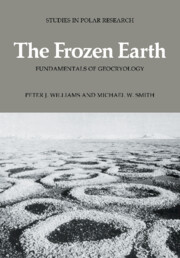Book contents
- Frontmatter
- Contents
- Symbols
- Preface
- Acknowledgements
- 1 PERIGLACIAL CONDITIONS
- 2 MORPHOLOGY OF PERMAFROST AND SEASONALLY FROZEN GROUND
- 3 CLIMATE AND FROZEN GROUND
- 4 THE GROUND THERMAL REGIME
- 5 THE FORMS OF THE GROUND SURFACE 1: SLOPES AND SUBSIDENCES
- 6 THE FORMS OF THE GROUND SURFACE 2: STRUCTURES AND MICROTOPOGRAPHY OF LEVEL GROUND
- 7 THERMODYNAMIC BEHAVIOUR OF FROZEN SOILS
- 8 HYDROLOGY OF FROZEN GROUND
- 9 THE MECHANICS OF FROZEN GROUND
- 10 GEOCRYOLOGY PAST AND FUTURE
- References
- Index
8 - HYDROLOGY OF FROZEN GROUND
Published online by Cambridge University Press: 24 October 2009
- Frontmatter
- Contents
- Symbols
- Preface
- Acknowledgements
- 1 PERIGLACIAL CONDITIONS
- 2 MORPHOLOGY OF PERMAFROST AND SEASONALLY FROZEN GROUND
- 3 CLIMATE AND FROZEN GROUND
- 4 THE GROUND THERMAL REGIME
- 5 THE FORMS OF THE GROUND SURFACE 1: SLOPES AND SUBSIDENCES
- 6 THE FORMS OF THE GROUND SURFACE 2: STRUCTURES AND MICROTOPOGRAPHY OF LEVEL GROUND
- 7 THERMODYNAMIC BEHAVIOUR OF FROZEN SOILS
- 8 HYDROLOGY OF FROZEN GROUND
- 9 THE MECHANICS OF FROZEN GROUND
- 10 GEOCRYOLOGY PAST AND FUTURE
- References
- Index
Summary
Introduction
The thermal conditions of cold regions are important to hydrology in a number of ways. At a macroscale, the various elements of the hydrologic cycle are modulated in intensity, magnitude and significance when compared to mid-latitude regions. For example, winter snow storage is the single most important feature of the hydrological cycle in cold regions, and each year, for six months or more, arctic water bodies are affected by ice. As a consequence, streamflow is intensely seasonal or even ephemeral. The spring melting of snow and ice, when soils are frozen and infiltration is limited, accentuates peak flows. On the Colville River in Alaska, the breakup period accounts for about 40% of the annual flow (Arnborg et al., 1967). On smaller rivers, the spring flood may account for as much as 90% of the discharge (e.g. McCann et al, 1972). In summer, the runoff response is modulated by the thawing of the active layer.
The groundwater regime is profoundly affected by the presence of permafrost, which limits infiltration and water movement. Where permafrost is continuous, the groundwater contribution to runoff is probably less than 10%, but can increase to 20–40% in regions of discontinuous permafrost (MacKay & Loken, 1974). In the fall, freezeback of the active layer can restrict subsurface flow, forcing it to the surface and resulting in unique features such as surface icings and frost blisters.
- Type
- Chapter
- Information
- The Frozen EarthFundamentals of Geocryology, pp. 202 - 236Publisher: Cambridge University PressPrint publication year: 1989



